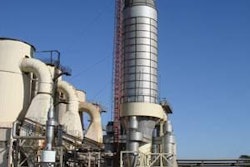.jpg?auto=format%2Ccompress&q=70&w=400)
We live in an age when virtually the entire world appears to be moving faster. The "bigger, faster, better" phenomenon is at the heart of everything to which we are exposed, from automobiles to televisions. For many of us, our "slow down and relax" time is the time we spend with our horses a little bit of solitude and tranquility away from the modern world. Even those of us who rely on horses to generate income probably do so in part because we can enjoy the pace of life that accompanies work with horses.
Unfortunately, the "bigger and better" concept has invaded the world of horses. People want faster runners, higher jumpers, more endurance and generally every desirable trait in an expanded capacity. Our desire to reach these seemingly unattainable goals has created a huge commercial market for an array of goods that promise to "make the difference."
Today's horsemen can empty their wallets on a virtually endless offering of products, from performance boots, gel pads, air ride saddles and designer bits to magnets and magic potions from ancient oriental medicine. Distinguishing the hype from the truth can often be beyond the ability of even the most well-intentioned horseperson.
Quest for improved performance
What is the solution to the competitive horseperson's need for improved performance? Does it come in a box or a bag, a needle or a pellet? The answer lies many steps back in the grand scheme of things within the horse itself. In all probability, it is hidden deep in the DNA that the sire and the dam contributed on the day of conception.
We cannot make an "average" horse great through nutrition, drugs or fancy tack and training aids. We can allow a horse the opportunity to reach his genetic potential by ensuring that his body can function at an optimum physiological level. When everything on the inside of your horse is running at peak physiological levels, he will feel good and will perform to the best of his ability.
How do we reach this condition of optimum physiology? There is no silver bullet. Hard work, excellent training and peak nutrition are the three keys to success. As physiological function is the core concept, everything comes down to single cells, while the case of a bigger, better and faster performance goal involves single muscle cells. The individual muscle cell, principally the heart muscle and skeletal muscle, are the key factors when performance is the principle measurement. Work, in its most basic sense, is the contraction of a single muscle cell multiplied by millions of similar cells in the equine body.
To ensure that this "work" can be accomplished over and over again under the stress of performance, it is imperative that each cell be provided optimum levels of essential nutrients. At the cellular level, the difference between a winning performance and second place may be measured in single ions of nutrients. It has often been said that the fastest horse does not win the race, but rather the horse that is the least tired. How do we ensure that our horses can produce critical muscle work, using optimum nutrition to meet genetic potential?
Microminerals support cellular functions
Microminerals such as copper, zinc, manganese, iron, selenium and chromium are active components in many cellular functions. They are involved as catalysts in cellular reactions, and some micronutrients like selenium are critical in detoxifying the potentially deadly by-products of normal metabolism. A considerable amount of research has been conducted into the absorption of these compounds to ensure an adequate micromineral supply. After all, if your horse does not absorb nutrients from the feed you provide, it does not matter how much is initially ingested.
In the case of micromineral nutrition, the focus has been on the use of chelated compounds. In simple terms, a chelated micromineral is one that has been "fused" with either a pure amino acid or a small segment of protein known as a peptide. The mineral becomes implicitly bound to the protein and loses its original chemical activity. For several years, the feed industry has promoted the inclusion of chelate-type minerals in horse feeds as additional "insurance" so that when it comes down to that single muscle contraction (work), everything necessary for cellular function will be available in optimal amounts.
Nutritionists believed for many years that the reason for improved absorption was that the mineral is carried across the intestinal wall disguised as something else by the protein; in other words, the mineral entered the bloodstream as part of the protein rather than being absorbed as a pure mineral. There is little published scientific literature to support this concept, but because it seemed to make sense, this became the theory of choice. Research reported by Dr. Ronan Power from Lexington, Kentucky, USA, confirms the belief that minerals in a chelate form are better absorbed than conventional sulphate and oxide forms; however, the mode of action has been determined to be quite different than previously suspected.
To comprehend how we can provide horses the trace mineral nutrition necessary for reaching an optimum physiological performance goal, it is necessary to understand the function of the mechanisms that regulate the uptake of mineral elements from the gastrointestinal tract.
Absorption key to mineral nutrition
The gastrointestinal tract of horses, man and all the other known mammals is actually a significant part of the body's natural defense mechanism against potentially destructive organisms and compounds. Prevention of absorption is a fundamental process in the protection against systemic diseases or poisoning by toxic compounds. However, the mechanisms that prevent potential harmful events also have negative implications on the absorption of critical nutrients such as iron, zinc, copper, manganese and cobalt. Circumventing these mechanisms to increase absorption is the key to optimal mineral nutrition.
As mentioned earlier, much of the micromineral content of the diet is never absorbed. Some of this absorptive loss is due to negative interactions between the mineral ions and dietary factors present in the bulk of the diet. Phytic acid present in forages and grains may bind metals like copper, zinc and iron into indigestible compounds that preclude absorption. Some sugar compounds and natural polyphenols are also known to complex with microminerals and inhibit absorption. A major detriment is the natural interaction between different trace elements. Essential mineral nutrients have very similar atomic structures and electronic states. They compete with each other for the limited number of active absorptive sites present in the intestinal wall. If there is a preponderance of one mineral over the others, absorption of the minerals present at lower concentrations is inhibited.
Another critical impediment to the absorption of an optimal level of micronutrient supplementation is the essential minerals' ability to stay in solution throughout the intestinal tract and be available for absorption. Minerals can be divided into two broad categories. The first includes minerals that remain in solution throughout the entire digestive tract irrespective of the pH of the solution. Generally, these tend to be the macrominerals like calcium, sodium and magnesium.
The second group are minerals that can undergo a process known as hydroxy-polymerisation. These tend to be microminerals and include zinc, copper, manganese and iron. In loose terms, these are minerals that are soluble in one part of the intestinal tract (the acidic portion near the stomach) and precipitate out of solution in the alkaline portion (the lower intestinal tract).
Hydroxy-polymerisation is a process that occurs as the environment goes from acidic to alkaline. Protons are released by the water molecules holding the essential nutrient in solution in an attempt to maintain a constant pH. As the process continues, the water can no longer hold the essential mineral in solution and it precipitates out of solution into a solid state unavailable for absorption. This is the ultimate fate of a very high percentage of absorbed mineral nutrients and explains why, in some cases, intake is adequate but absorption is minimal.
It would be natural to assume that if our essential micromineral nutrient can stay in solution long enough to reach the portion of the intestines where it can be absorbed, the problem is solved. However, the object of digestion and the digestive tract is to propel the required nutrients through the lumen of the intestines and towards the intestinal villi where they will ultimately be absorbed. Scientists have discovered that there are two remaining functional barrier layers that can limit the absorption of essential micro-minerals.
The first layer is a layer of undisturbed water that measures about 600 micrometres thick. Under this layer is a coating of mucous that covers the villus lining of the intestines. This lining of mucous, which is only 50 to 100 micrometres thick, is similar in nature to the mucous that is found in your horse's respiratory tract and is expelled when they snort. These two combined layers are the last line of protection for the actual cells that make up the absorptive lining of the intestines.
These last two layers are more than simple physical obstacles between the lumen of the intestine and the cellular walls. The unstirred water layer and the mucous layer have a pH microclimate quite different from that of the bulk of the intestinal contents. These layers are less alkaline and tend to be maintained at a pH of 7 (neutrality) or just slightly acidic. This may be due in part to the secretion of bicarbonate from the mucosal cells and its buffering ability. You will recall that essential micromineral nutrients were soluble in the more acidic areas of the gastrointestinal tract and became insoluble as the pH went from acid to alkaline. In a small way, the moderated pH of the unstirred and mucosal layers may counteract the insolubility of some minerals as they approach the absorptive surface of the intestines.
The final frontier that an essential mineral has to conquer is the mucous material secreted by goblet cells located throughout the walls of the intestines. By its chemical composition, mucous has a very strong negative electric charge; consequently, mucous has an incredibly strong ability to bind micronutrients just before they reach the site of absorption. Mucous is the body's last line of defense against toxic substances entering the bloodstream.
Quality of chelate essential
There is much more to ensuring that your horse receives optimum micromineral nutrition than simply filling his feed with high levels of copper, zinc, iron or one of the other essential nutrients. The mineral must first be able to avoid being bound by various compounds, avoid being precipitated out of solution, and finally, traverse the unstirred water layer and avoid being trapped by the electrically charged mucous layers protecting the actual intestinal lining.
Our previously accepted theory that chelated trace mineral absorption depended on the protein compound disguising the mineral did not consider the environmental factors. More attention was focused on the protein/mineral compound crossing the cell membrane than the process of presenting the mineral to the site of absorption. It now appears that how we present the micromineral nutrient to the absorptive surfaces is both our primary concern and the key to successfully completing the journey.
Presentation of the essential micronutrient to the absorptive surface of the intestinal villi in the form of a chelate is the answer. The quality of the chelate, and therefore its effectiveness, depends on the nature of the bonds that hold the mineral to the amino acid or peptide. Scientists call the protein component of a chelate the ligand, a molecule or an ion that has electrons that can be shared with the mineral.
The quality of the chelate depends on the quality of the ligand. The ligand in a high quality chelate is able to prevent or interfere with hydroxy-polymerisation and also prevent the mucous layer from electronically interfering with transport. While it is strong enough to carry the mineral to the site of absorption, a good ligand cannot be so powerful that the mineral cannot be released for uptake or metabolic utilisation.
So, in what form should we feed our trace minerals for the best results? As always, it seems that Mother Nature has known all along. The trace minerals we find in plants provide the active components in enzymes responsible for plant functions such as photosynthesis. Enzymes are proteins and as such are nature's original trace mineral chelates. The problem is that the levels found in forages and grains are simply not enough to satisfy the requirements of the equine athlete.
However, scientists have used the template provided by nature to provide trace minerals in a form that is as close as possible to what we find in nature. For example, the Bioplex® mineral range from Alltech of Lexington, Kentucky, USA, are trace minerals bound to a combination of amino acids and short protein chains, thereby protecting the mineral through the challenges of the digestive tract resulting in delivery of more trace mineral to the sites of absorption and thus increasing trace minerals status and all the benefits that this provides.
Bigger, faster, and better apparently may depend not only on the amount of trace mineral nutrition that is provided, but also the form in which it is available. Optimal performance will depend not just on the form (a chelate complex) but also on the quality of the protein or amino acid presented to the trace mineral to form the chelate. Optimal trace mineral nutrition requires an optimal match between the metal ion and the ligand presented to form the chelate complex.
To view, click Figures one and two.





.jpg?auto=format%2Ccompress&fit=crop&h=167&q=70&w=250)











